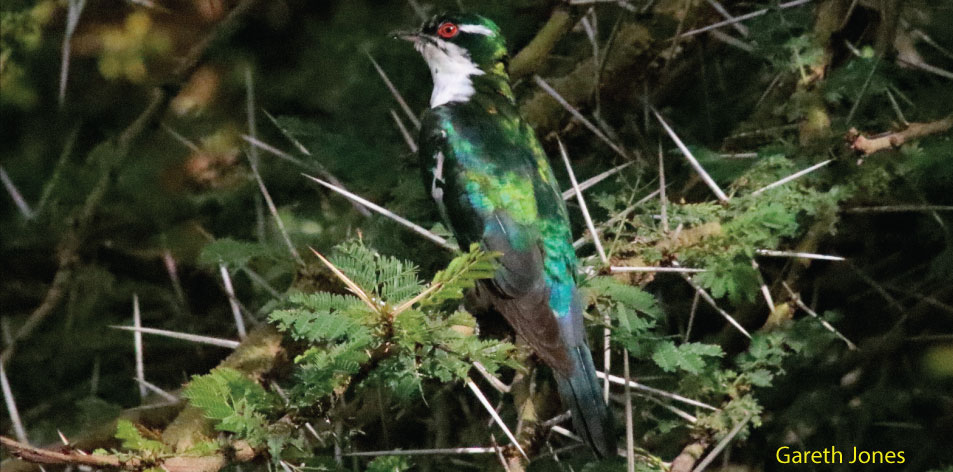
The Cunning Cuckoo!!!- Article by Gareth Jones
The Cunning Cuckoo In The Nairobi National Park
Early one weekend morning, we ventured into the Athi basin, and eventually arrived at the Athi dam. This particular dam is always a rewarding place to sit quietly and watch nature happening around you. There are always animals coming and going to drink, plus many aquatic birds species on the shoreline. After sitting for a while, I drove towards the dam wall, when suddenly I saw a flutter of movement on my left. Then as it turned with the sun shining on it, the diederik cuckoo looked beautiful as glossy shades of emerald green glistened on its shiny feathers. Thankfully, this particular cuckoo seemed to be pre-occupied with finding breakfast snacks, as it hopped and flew all around the small trees near the dam.
Diederik Cuckoos are more often heard than seen, their call is unmistakable. This cuckoo is a noisy species, with the persistent and loud deed-deed-deed-deed-er-ick call from which it gets its name. Usually four clear, roughly identical “deed” sounds followed by a low-key little twitter “er-ick”. To be able to actually spent some time with a diederik cuckoo is quite unusual, and interesting. All too soon, the hungry bird decided to fly away, no doubt in search of more tasty breakfast snacks, mostly in the form of juicy caterpillars, but they also feed on various types of insects.
The diederik cuckoo (Chrysococcyx caprius), is a member of the cuckoo order of birds, the Cuculiformes. The generic name Chrysococcyx combines the Ancient Greek khrusos meaning “gold” and kokkux meaning “cuckoo”. Caprius is from the Latin cupreus meaning “coppery”. So the name in Latin virtually means “golden coppery cuckoo”. The common name “diederik” comes from the Afrikaans word “diedrik”, that almost mimics the bird’s call. They are a smallish cuckoo species at 18 to 20 cm. Adult males are glossy green above, with copper-sheened areas on the back and whitish underparts. While they are found in the Nairobi National Park, diederik cuckoos are in certain locations found to be common resident breeders within Sub-Saharan Africa and the southern Arabian Peninsula. They are short-distance seasonal migrants, moving with the rains. Mostly solitary birds, found in open woodland, savanna and riverside bushes.
However, these beautiful birds have a particularly cunning method of ensuring their species has a future. The diederik cuckoo is a brood parasite. It lays a single egg mostly in the nests of weavers, especially the village weaver, and it has been recorded to lay eggs in red-collared widowbird nests. Simply speaking, to qualify as a brood parasite, this cuckoo species invades the nests of other unsuspecting birds by laying an egg in their nest when they are not there. In many cases, the cuckoo also removes the eggs that the host bird has laid. Sometimes, the unsuspecting host bird doesn’t detect any foul play, and continues to sit on the egg until it hatches. Female parasitic cuckoos sometimes specialize and lay eggs that closely resemble or almost mimic the eggs of their chosen host. The host bird then needs to work very hard to supply food to a very demanding cuckoo chick. In nests where the young of the host birds survive hatching, the cuckoo chick is known to push them out of the nest. According to those who have spend many hours studying various cuckoo species, only about 40% of the 150 cuckoo species are inclined to be classified as brood parasites. Some cuckoos have been known to lay close to 50 single eggs in different nests over a single annual breeding season, supposedly to increase the possibility of their survival rate, versus the host species finding out and destroying the cunning cuckoo’s egg.
From a human perspective, the actions of many cuckoo species like the diederik cuckoo are seemingly brutal, while the cuckoos might just see their cunning and cold strategy as a method of ensuring “survival of the fittest”. As sane and loving humans, we obviously cannot comprehend such bird-brained behaviour, as responsible parents choose to nurture and care for their babies until they are old enough to confidently leave home.
It can be very therapeutic to escape from this fast and furious world for a moment, find a quiet place, and let our feathered friends, sing for your souls. It is truly a “soul tonic” or a “dawa” for our innermost being. The park has a great variety of birds when compared to the world. Worldwide it is estimated that there are about 10,000 bird species, in East Africa it is estimated that there are just under 1,500 bird species, and a tiny little place of less than 117sq km, that we call the Nairobi National Park has as many as 550 species at certain times, and some of them like the bee-eaters have beautiful colours, birds like Kingfishers, Narina trogon, Bushshrikes, Grey crowned cranes, Saddle-billed storks, seed eating birds, various ducks and many more. A bird identification book for East African species is also useful to keep in the car when driving. The park is looking different at the moment due to the change of seasons and many migrant bird species are visiting at the moment.
I always find it a joy to see birds when driving in the park, God has created so, such amazing diversity. When we go with the attitude of “bird watching”, all too often the larger species like Rhino, Buffalo, and even Lions, just “get in the way”! Next time you are in the park, listen carefully for the unmistakable sound of “deed-deed-deed-deed-er-ick”, and then if you look around you might be rewarded with an interesting cuckoo sighting.


